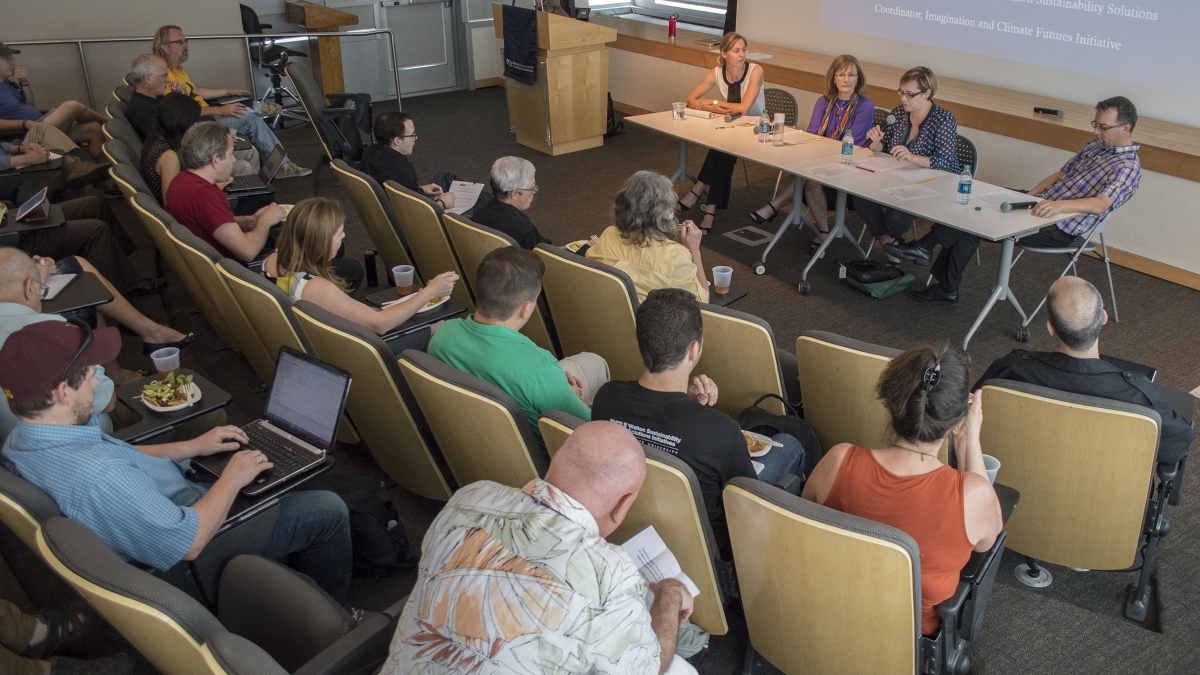Contest challenges writers to imagine futures shaped by climate change

The ASU Imagination and Climate Futures Initiative hosted a climate fiction panel in April that included a flash fiction exercise to devise stories about Arizona's future water and drought scenario.
Photo by: Jason Franz/Walton Sustainability Solutions Initiatives
ASU to award $1,000 to top climate fiction short story
The challenge with climate change is that it’s gradual — a pervasive, creeping calamity that can be difficult for people to accept or comprehend. But, what if people could understand it better by escaping their everyday realities?
Speculative fiction stories have the power to take policy debates and obscure scientific jargon and turn them into gripping, visceral tales. The emerging subgenre of climate fiction, epitomized by novels like Margaret Atwood’s Maddaddam Trilogy, helps us to imagine futures shaped by climate change in deeply human terms.
The Imagination and Climate Futures Initiative at Arizona State University, in partnership with the College of Liberal Arts and Sciences Dean’s Council, invites writers to submit short stories that explore climate change, science and human futures for its first Climate Fiction Short Story Contest. The submission deadline is Jan. 15, 2016, and contest entry is free.
“Climate change is starting to appear as a character in all our stories, so there is no better time to invite creative visions of how humanity will face these challenges,” said Ed Finn, co-director of the Imagination and Climate Futures Initiative.
The contest will be judged by science fiction legend Kim Stanley Robinson, the award-winning and New York Times-bestselling author of many foundational works in climate fiction, along with other experts from the Imagination and Climate Futures Initiative.
"This contest is a wonderful idea and I'm happy to be part of it,” said Robinson. “There's a thrill to writing and reading fiction that can't be matched by any other activity. As we move into the climate change century, the stories we tell each other about coping with it are going to be a crucial part of our thoughts and actions, so I urge people to give this contest a try and see what happens.”
The grand-prize winner will be awarded $1,000, with three additional finalists receiving book bundles signed by award-winning climate fiction author Paolo Bacigalupi. A collection of the best submissions will be published in a forthcoming online anthology, and considered for publication in the journal Issues in Science and Technology.
Stories are required to envision a future for Earth and humanity that is transformed in some way by climate change. They should also reflect current scientific knowledge about climate change and its consequences for human societies and the environment. The jury is particularly interested in stories that illuminate the political, ethical and technological challenges that individuals and communities must confront in the face of climate change.
"Merging climate science and deeply human storytelling, climate fiction can be a powerful learning tool,” said Manjana Milkoreit, Walton Sustainability postdoctoral research fellow at ASU. “Taking the reader into a possible future, a story can turn modeling scenarios and temperature graphs into meaning and emotion. It can help us make sense of and respond to this incredibly complex problem."
For full contest rules and details, and a link to submit stories for consideration, visit climateimagination.asu.edu/clificontest.
The Imagination and Climate Futures Initiative is a partnership between the Rob and Melani Walton Sustainability Solutions Initiatives, the Virginia G. Piper Center for Creative Writing, and the Center for Science and the Imagination. It explores how imagination — or lack thereof — shapes humanity’s response to climate change, and how imagination merged with science can create solutions to climate challenges. The initiative hosts public events, offers courses at the intersection of art, literature and climate science as well as encompassing research projects uniting scholars and practitioners from a broad range of disciplines.
More Environment and sustainability

ASU President Michael Crow named to TIME100 Climate list
Arizona State University President Michael Crow has been named to the 2024 TIME100 Climate list of leaders and innovators driving…

Driving green desalination
Wilderness survival TV show hosts, pirates and water treatment researchers agree on one thing: Most natural water sources are not…

ASU preservation facility serves as test bed for rooftop heat mitigation
A roof coating that uses thermal energy storage materials from Arizona State University spinout EnKoat is halting the heat in…